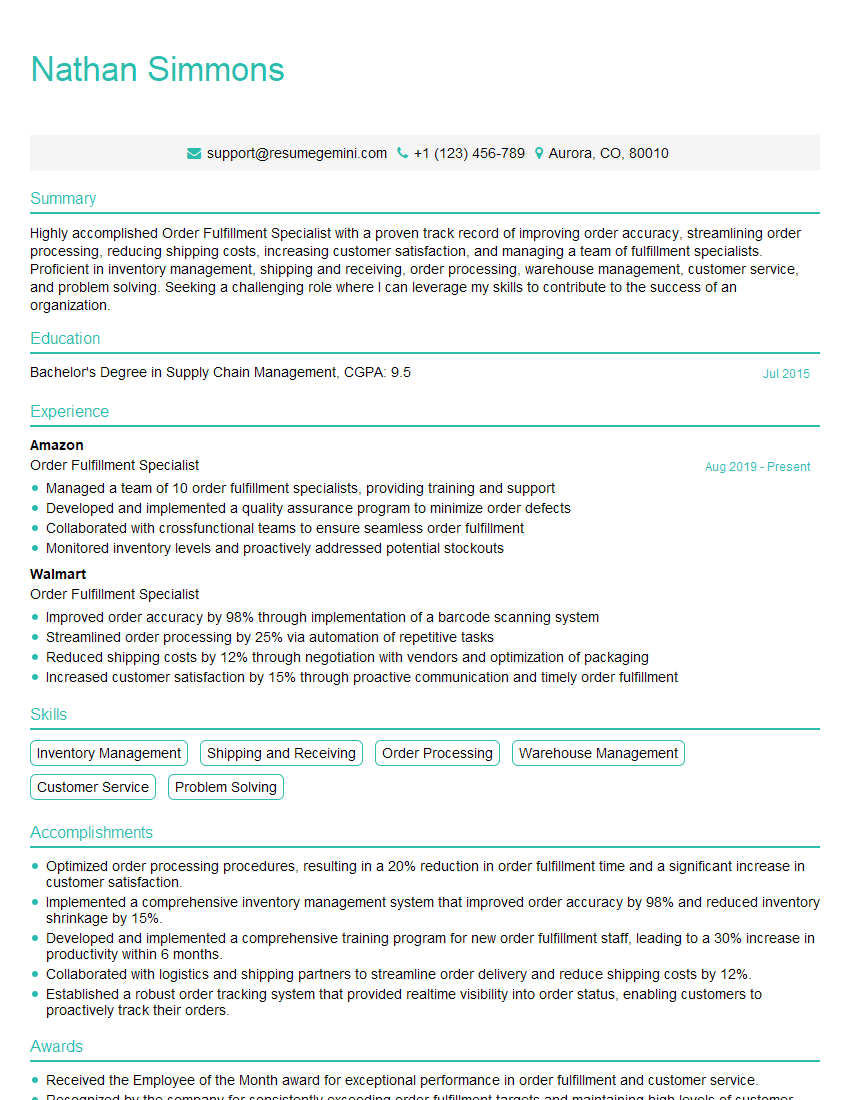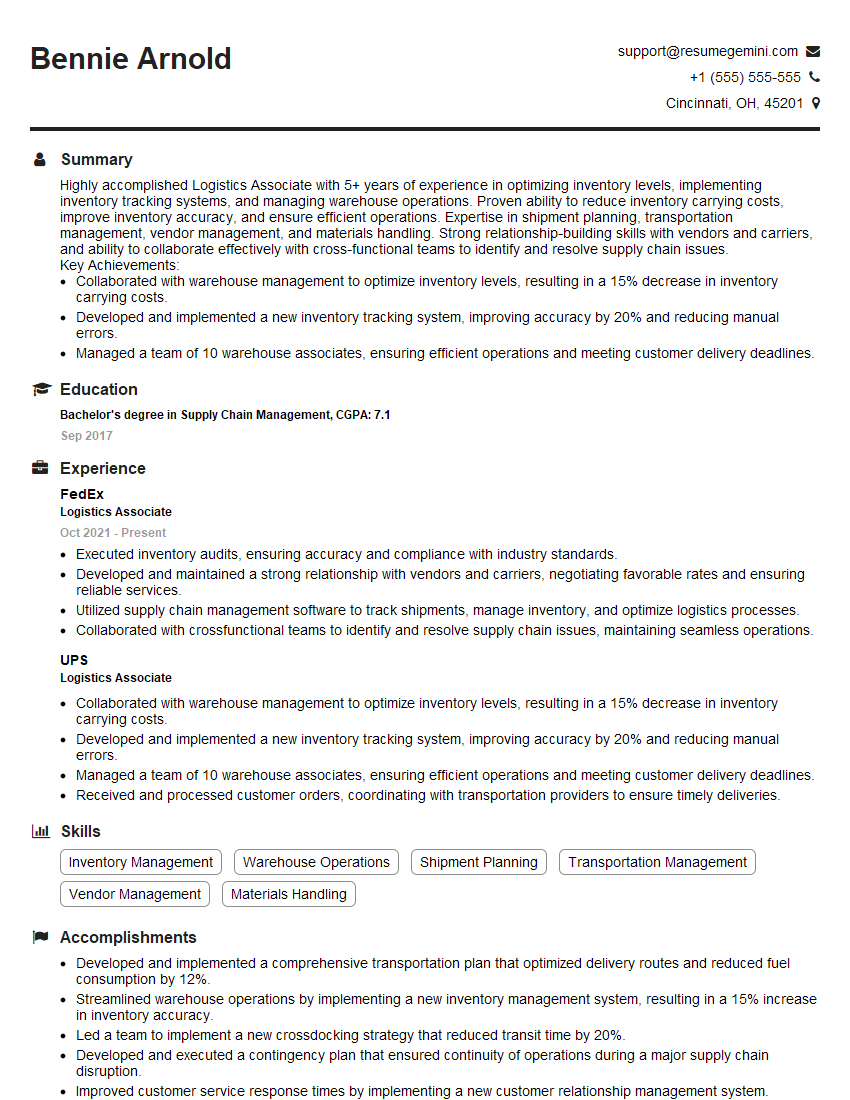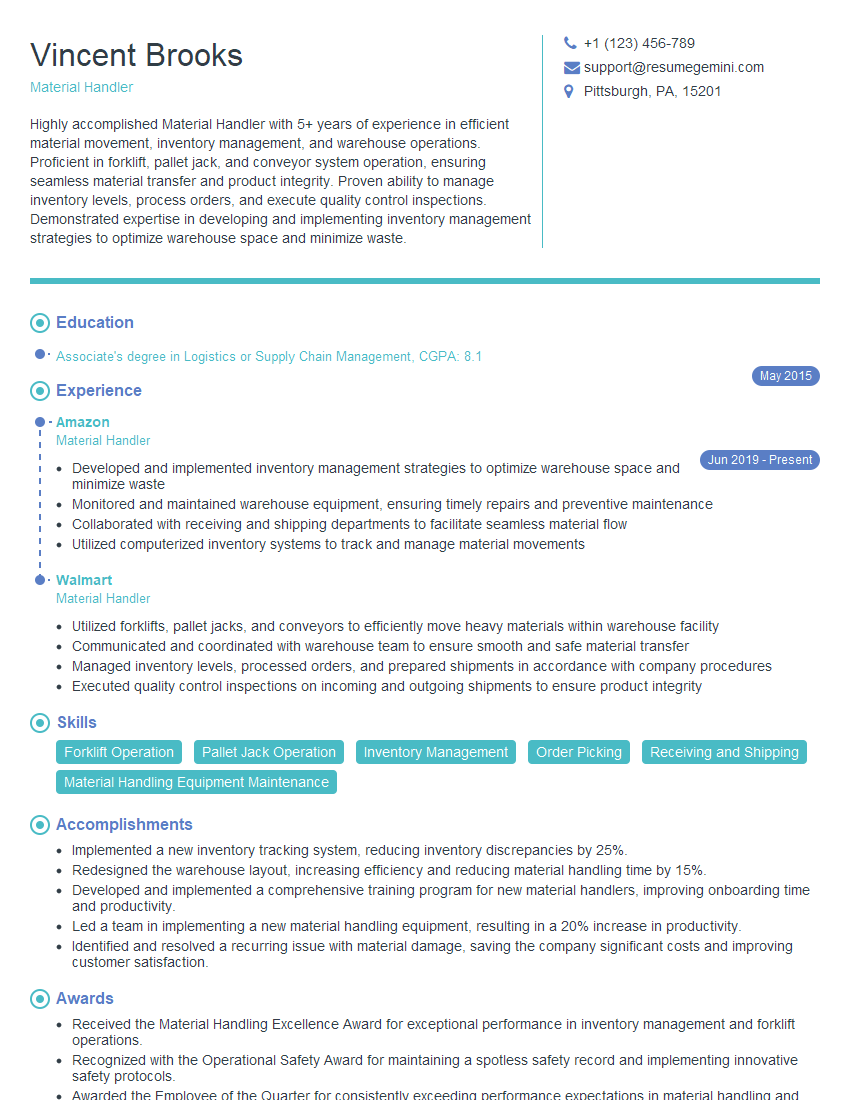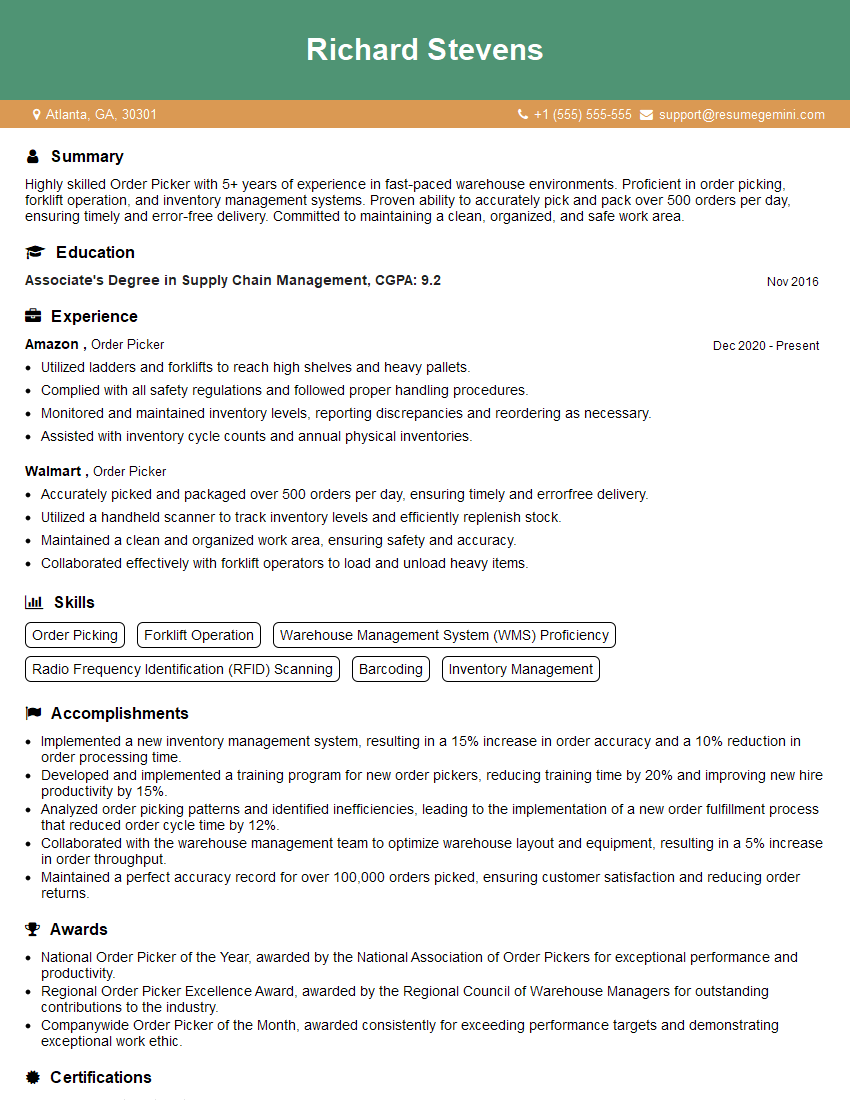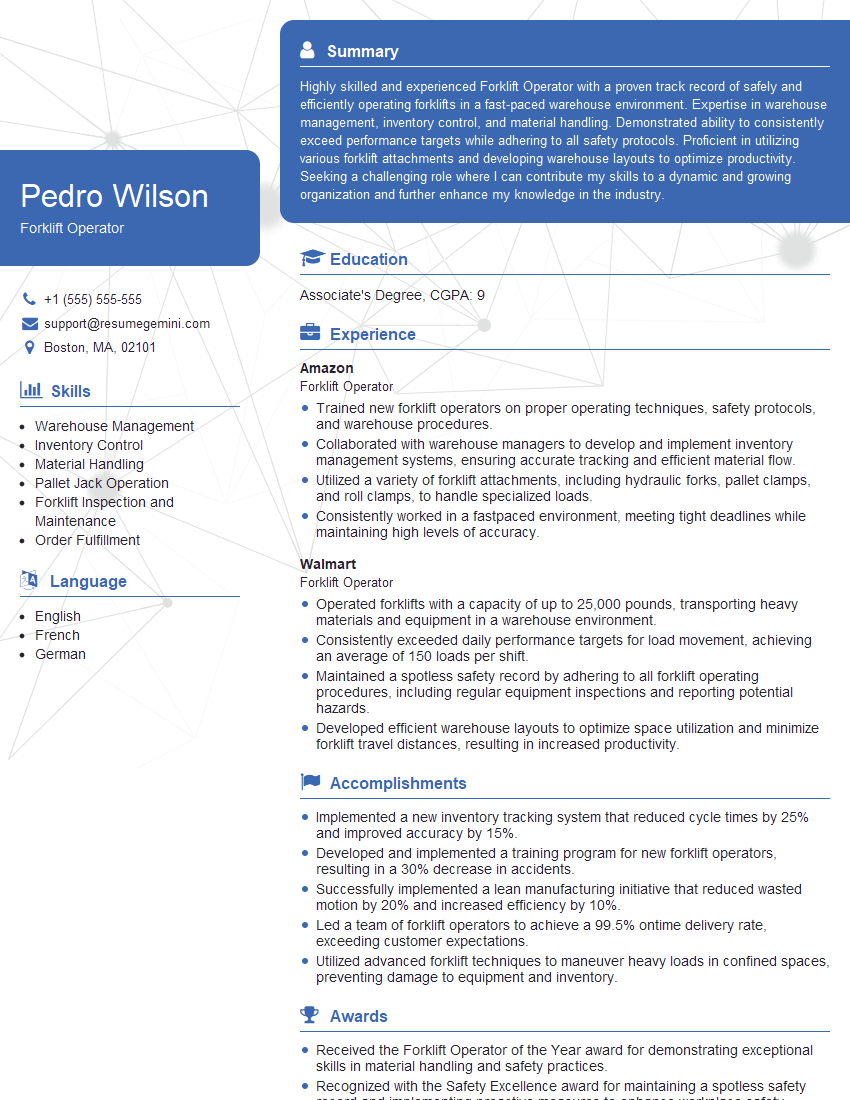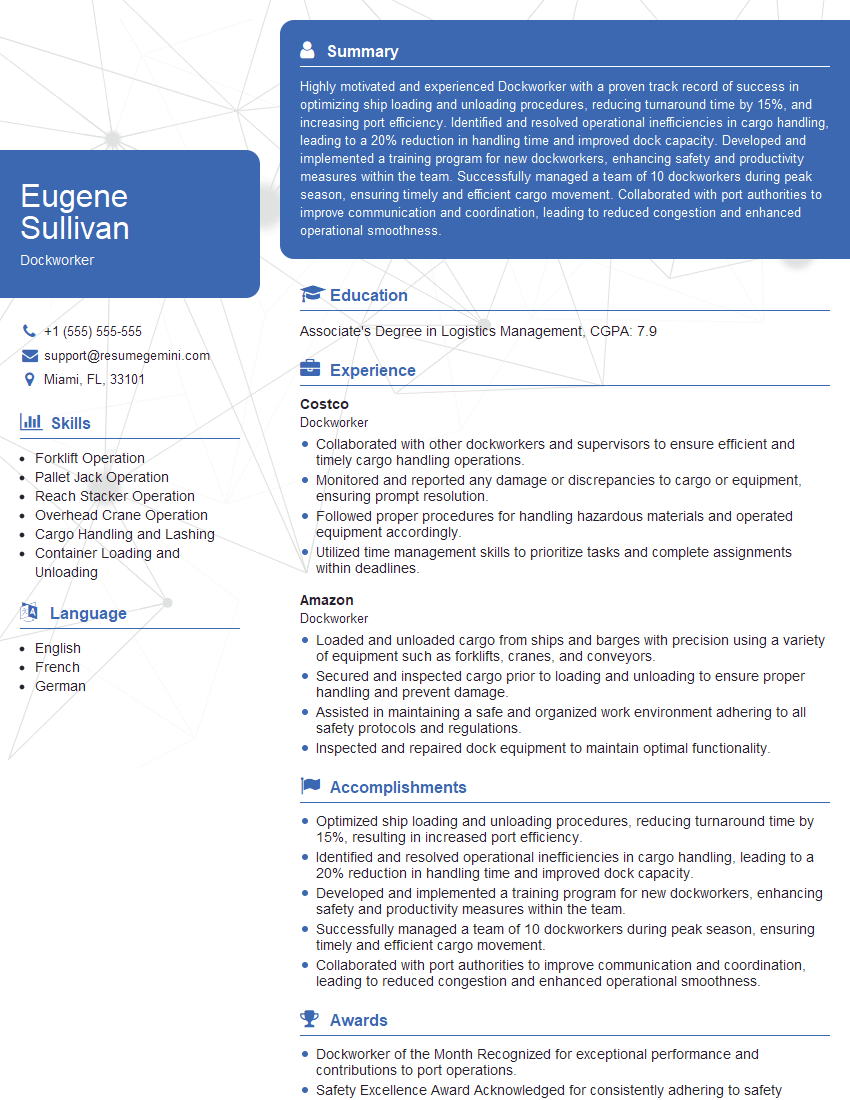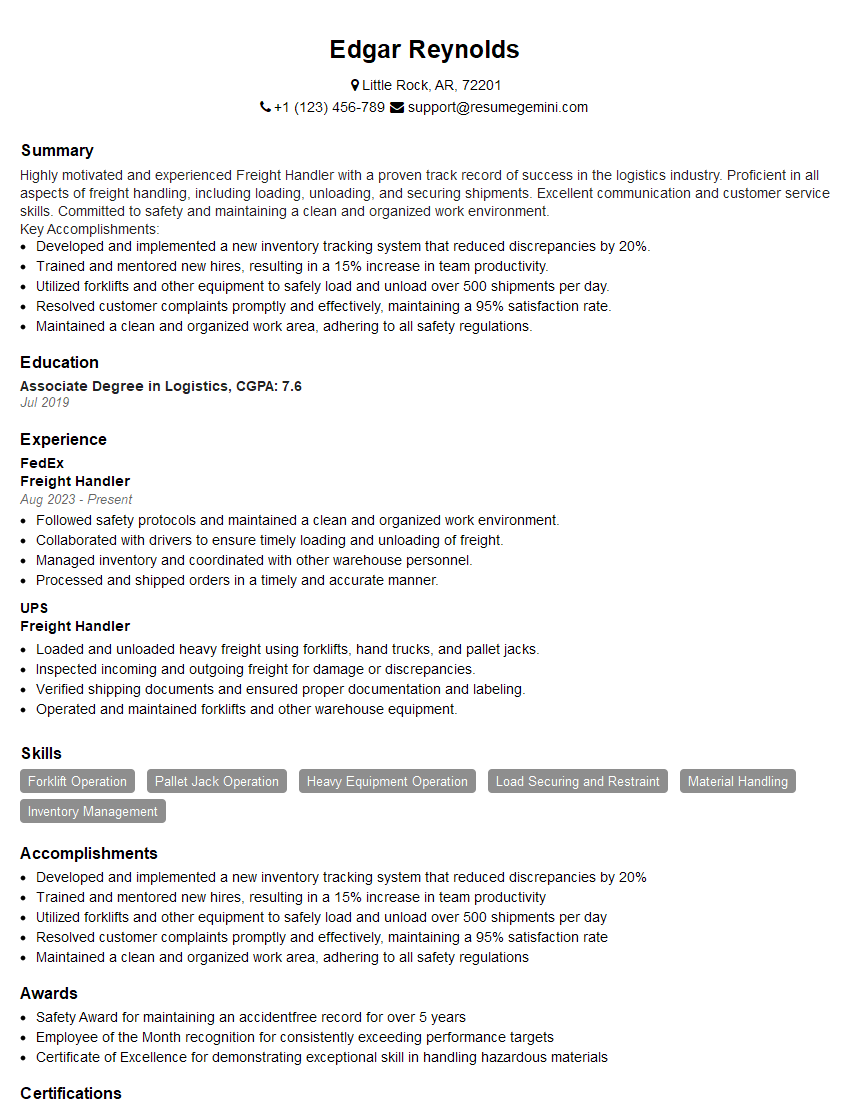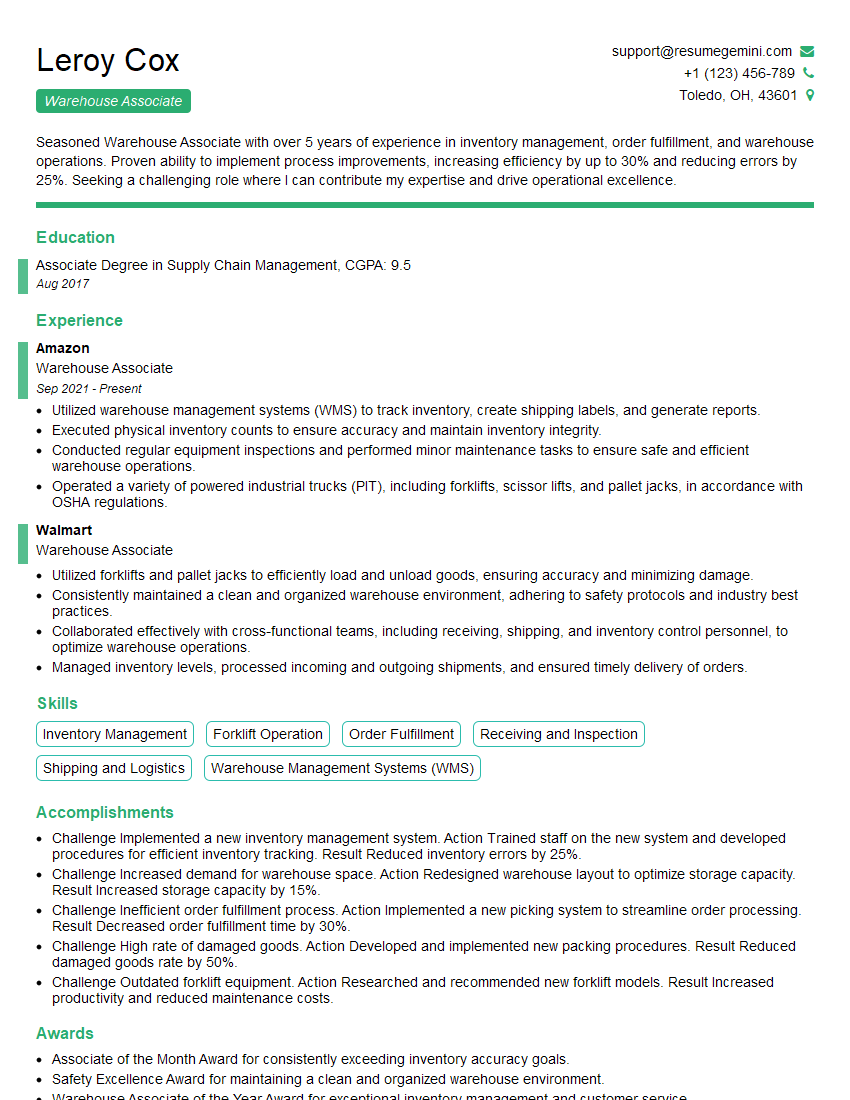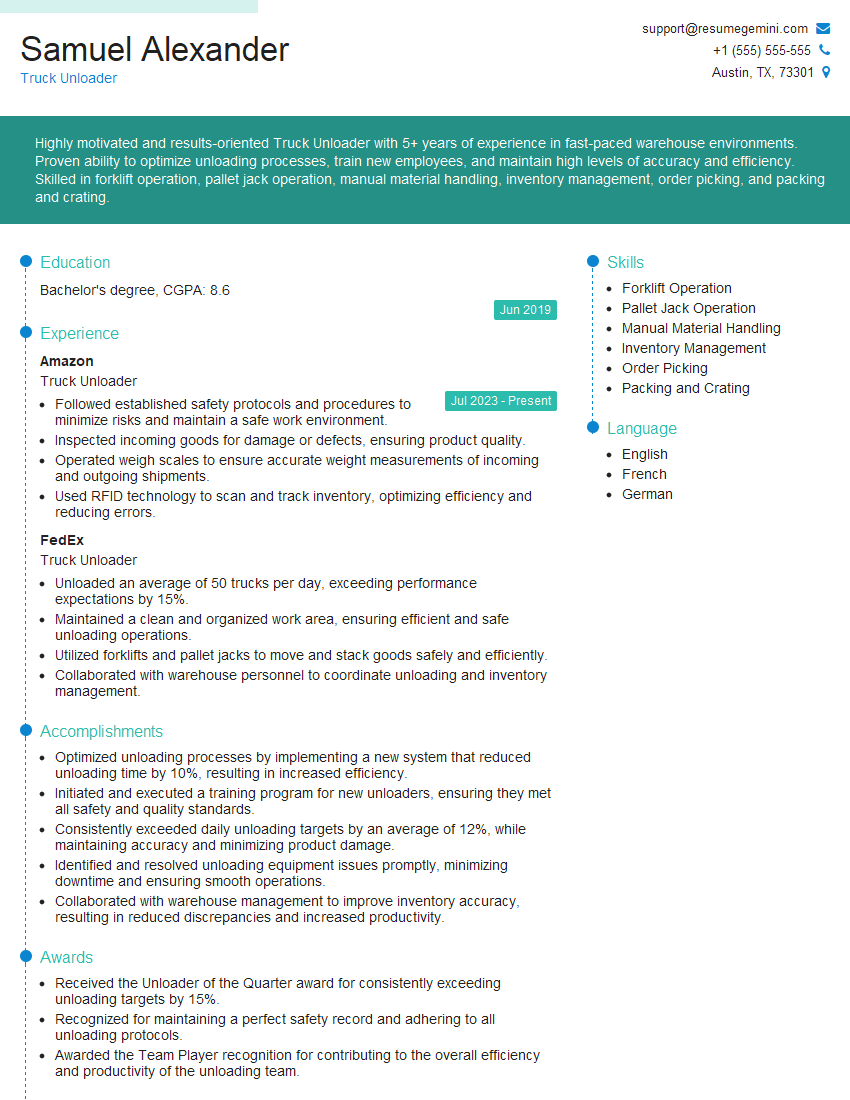Preparation is the key to success in any interview. In this post, we’ll explore crucial Experience in loading and unloading trucks interview questions and equip you with strategies to craft impactful answers. Whether you’re a beginner or a pro, these tips will elevate your preparation.
Questions Asked in Experience in loading and unloading trucks Interview
Q 1. Describe your experience in safely loading and unloading various types of cargo.
Safe loading and unloading hinges on understanding the cargo’s characteristics and applying appropriate handling techniques. My experience spans a wide range of goods, from delicate electronics requiring specialized padding and bracing to heavy machinery demanding precise placement and securing. I’ve worked with palletized goods, loose items, and oddly-shaped objects, adapting my approach each time.
For instance, when loading fragile ceramics, I prioritize careful placement, using ample cushioning material like bubble wrap and packing peanuts. Each item is individually wrapped and secured within the pallet to prevent shifting during transit. Conversely, when loading heavy steel beams, I employ specialized equipment like forklifts and straps to ensure secure and stable placement, preventing potential toppling or damage. Proper weight distribution within the truck is also crucial to maintaining balance and stability during transport.
In all cases, my approach emphasizes meticulous planning and execution to minimize risk of damage or injury.
Q 2. What are the different types of equipment you’ve used for loading and unloading?
Throughout my career, I’ve become proficient in operating a variety of loading and unloading equipment. This includes:
- Forklifts: Used extensively for moving palletized goods efficiently and safely. I’m certified in forklift operation and adhere to strict safety protocols.
- Pallet jacks: Ideal for maneuvering pallets over shorter distances within the warehouse or loading dock.
- Conveyors: In facilities equipped with conveyor systems, I’ve utilized these to streamline the movement of goods, speeding up the loading and unloading process.
- Hand trucks: For smaller or more awkwardly shaped items.
- Strapping equipment: Essential for securing heavy or unstable loads to prevent shifting during transit. I’m experienced in using both manual and powered strapping tools.
- Crane Systems (in certain situations): For heavier items that demand more powerful lifting capabilities.
My experience with this diverse range of equipment allows me to select the most appropriate tool for the job, maximizing efficiency and safety.
Q 3. Explain your process for verifying the quantity and condition of goods before and after loading/unloading.
Verifying the quantity and condition of goods is a non-negotiable step in my process. Before loading, I carefully cross-reference the bill of lading with the actual goods, ensuring both quantities and product descriptions match. I visually inspect each item or pallet for any pre-existing damage, documenting any discrepancies with photos or notes. After unloading, I perform a similar check, noting any damage incurred during transit. This involves comparing the received goods with the delivery manifest.
For example, if I’m loading a shipment of 100 boxes of electronics, I’ll count each box to ensure the quantity is correct. I would also check for any signs of damage like dents or tears in the packaging. Any discrepancies are immediately reported to my supervisor.
This thorough approach ensures accountability and protects both the shipper and the receiver from potential losses.
Q 4. How do you prioritize tasks when handling multiple shipments simultaneously?
When managing multiple shipments simultaneously, I prioritize tasks based on several factors: urgency (e.g., time-sensitive deliveries), delivery deadlines, and the type of cargo (e.g., perishable goods needing immediate attention). I use a combination of visual aids like whiteboard schedules and efficient organizational techniques to manage and track shipments. This prevents delays and maintains optimal workflow.
For example, if I have a shipment of frozen food alongside a general merchandise shipment, I would prioritize the frozen food to prevent spoilage. I might allocate specific loading bays and equipment to individual orders, further optimizing the process.
Effective communication is vital. I maintain clear lines of communication with warehouse personnel, supervisors, and drivers to ensure everyone is informed of priorities and potential issues.
Q 5. Describe a time you had to handle a damaged shipment during loading or unloading. What did you do?
During the unloading of a shipment of furniture, I discovered a significant crack in a high-end antique dresser. I immediately stopped the unloading process for that specific pallet to prevent further damage. I documented the damage with detailed photographs from multiple angles, noting the extent of the crack and its location. I then carefully moved the damaged piece to a designated area for inspection and further handling instructions from my supervisor. I also contacted the receiving party to inform them of the situation. This prompt response helped minimize potential disputes and ensured that the damage was properly documented and handled.
The key is to always act swiftly and decisively, ensuring comprehensive documentation at every step.
Q 6. How do you ensure the safety of yourself and others during loading and unloading operations?
Safety is paramount. My commitment to safe loading and unloading practices begins with adhering to all company safety regulations and wearing appropriate personal protective equipment (PPE), including safety shoes, high-visibility vests, and gloves when necessary. I regularly inspect equipment before use to ensure it’s in good working order. I avoid rushing, maintain a clear and organized workspace, and constantly assess my surroundings for potential hazards. I also actively communicate with my colleagues and ensure clear communication regarding loading and unloading procedures to eliminate any potential misunderstanding.
Before any operation, I perform a thorough risk assessment, carefully planning the placement of materials to avoid obstacles and prevent falls or collisions. If operating machinery like forklifts, I follow all safety protocols to the letter.
Q 7. What are your strategies for maintaining efficiency while loading and unloading trucks?
Maintaining efficiency relies on careful planning, skilled execution, and effective teamwork. This begins with understanding the layout of the truck and the location of goods to optimize loading and unloading sequences. Utilizing appropriate equipment, maintaining a clear workspace, and working efficiently as a team are crucial. I constantly look for ways to improve my techniques, learning new approaches and streamlining my processes. For instance, I strive to perfect my forklift skills, ensuring the most efficient path for loading pallets and minimizing wasted motion. Properly organizing the loading bay and using check-lists for receiving and delivering reduces delays.
Continuous improvement and attention to detail is key to maintaining high efficiency without sacrificing safety.
Q 8. How familiar are you with different types of truck loading docks and equipment?
My experience encompasses a wide range of loading dock types and equipment. I’m familiar with everything from simple, ground-level docks to those equipped with hydraulic lifts, levelers, and conveyors. I’ve worked with various dock configurations, including recessed docks, edge-of-dock levelers, and those with specialized ramps for oversized loads. Understanding the specifics of each setup is crucial for safe and efficient loading and unloading. For instance, I know the importance of securing the leveler properly before any truck backs into the dock to prevent accidents. I’m also proficient in operating various equipment like pallet jacks, forklifts (with appropriate certifications), and hand trucks. The choice of equipment depends on the type of cargo, its weight, and the layout of the loading area. I can quickly assess the situation and select the most appropriate tools for the job.
For example, I’ve handled situations where a dock leveler malfunctioned requiring immediate troubleshooting and the use of alternative methods to ensure timely loading. I also have experience with different types of dock seals and shelters which help maintain a controlled and safe environment, especially in inclement weather.
Q 9. What are some common safety hazards associated with loading and unloading trucks, and how do you mitigate them?
Safety is paramount in my work. Common hazards include slips, trips, and falls due to uneven surfaces, spills, or poorly stacked pallets. Another major concern is struck-by hazards from moving equipment or improperly secured loads. Back injuries from manual handling are also frequent risks. I mitigate these by adhering strictly to safety protocols. This includes wearing appropriate personal protective equipment (PPE), such as safety shoes, high-visibility vests, and gloves. I always ensure the area is well-lit and clear of obstructions. I utilize proper lifting techniques to prevent back injuries and always work within my physical capabilities. When using machinery, I perform thorough pre-operational checks and follow all safety procedures. For example, I’d always make sure to use spotters when backing up with a forklift or pallet jack in a confined space.
Proactive measures are critical. Before each load, I conduct a thorough inspection of the truck, the dock, and the surrounding area. I identify and address any potential hazards before starting the process. Team communication is vital; I clearly communicate with drivers and fellow workers to coordinate movements and avoid collisions or mishaps. We’re trained to recognize and respond to unsafe conditions immediately, escalating concerns to supervisors when necessary.
Q 10. Describe your experience with inventory management related to loading/unloading.
My experience with inventory management in loading and unloading is extensive. I’m not just involved in the physical act of moving goods; I play a key role in ensuring accuracy and efficiency throughout the entire process. This starts with verifying the shipment against the accompanying paperwork – the bill of lading or packing slip. I meticulously check the quantity, type, and condition of each item against the manifest. Any discrepancies are immediately noted, and I initiate the appropriate procedures to resolve them. I am comfortable with using handheld scanners to scan barcodes, recording data directly into the inventory management system, ensuring real-time updates. This enables better tracking of goods, reduces potential errors, and optimizes overall inventory control.
For example, in one instance, we discovered a significant discrepancy between the inventory count and the actual amount of goods received. By carefully reviewing the packing slips and conducting a thorough recount, we pinpointed the source of the error, leading to adjustments in our receiving procedures to improve accuracy and prevent similar situations.
Q 11. How do you handle discrepancies between the shipment manifest and the actual cargo?
Discrepancies between the manifest and actual cargo require immediate attention. My first step is to carefully re-check the paperwork against the physical goods, paying close attention to details such as product codes, quantities, and condition. If the discrepancy persists, I document the issue meticulously. This includes taking photographs or videos, noting the exact nature of the discrepancy, and obtaining the driver’s signature acknowledging the issue. I then immediately report the discrepancies to my supervisor or the designated contact person, providing all relevant documentation. We then work collaboratively to resolve the issue. This may involve contacting the shipping company, conducting a more detailed inventory check, or initiating damage claims, if necessary. We must maintain a clear audit trail of all actions taken to ensure accountability and resolve the issue efficiently.
I’ve dealt with various discrepancy types, from simple counting errors to significant damage claims. In one case, a substantial portion of the shipment was missing. Following the established protocol, we thoroughly documented the discrepancy, contacted the shipper, and initiated a claim investigation. The documentation and our systematic approach were instrumental in resolving the issue successfully.
Q 12. What is your experience with using scanners or other technology for tracking shipments?
I have extensive experience utilizing scanners and other technologies for shipment tracking. I’m proficient in using barcode scanners, RF (radio frequency) scanners, and various inventory management software. These technologies significantly improve efficiency and accuracy. Scanning barcodes allows for immediate data entry, reducing manual data entry errors and ensuring real-time updates to inventory levels. I’m also familiar with using handheld mobile devices for real-time tracking, updating shipment statuses, and facilitating communication with other team members and the warehouse management system.
For example, our company utilizes a wireless system that allows us to scan items as they’re being loaded, sending this information directly to the warehouse management system. This real-time tracking provides up-to-the-minute visibility into inventory movements, which is critical for efficient order fulfillment and timely delivery.
Q 13. How do you maintain accurate records of loaded and unloaded goods?
Maintaining accurate records of loaded and unloaded goods is crucial. We typically use a combination of electronic and paper-based systems. Electronic systems include warehouse management systems (WMS), where we can scan items, record quantities, and track their movement. This system provides real-time visibility and an audit trail. Paper-based systems include bills of lading, packing slips, and internal receiving reports. These documents are meticulously completed, signed, and filed according to company procedure. All documentation must reflect a complete and accurate account of the goods handled. Double-checking and reconciliation are integral parts of our process to ensure accuracy and prevent discrepancies.
For example, each load receives a unique identification number that is tracked throughout the entire process, from receiving to shipping. This ensures complete traceability and allows for easy retrieval of relevant data, should it ever be required.
Q 14. Describe your experience working with different types of packaging and securing methods.
My experience extends to a variety of packaging types and securing methods. I’m familiar with handling various materials like cardboard boxes, crates, pallets, drums, and other specialized containers. Understanding the appropriate securing methods for each packaging type is vital. I use techniques such as proper stacking, bracing, and securing materials with straps, shrink wrap, or other appropriate means. This is crucial to prevent damage during transit and ensure safety during handling. I understand the importance of selecting appropriate pallets based on weight and cargo characteristics to avoid collapse. For instance, we use different types of stretch wrap, depending on the weight of the pallets to ensure the load is securely held in place.
I’ve worked with fragile items requiring specialized packaging and handling. I have experience with materials like bubble wrap, air pillows, and foam padding, as well as specialized load securing methods for items prone to damage like glassware or electronics. I’m also familiar with HAZMAT regulations and the special handling procedures required for hazardous materials.
Q 15. What is your understanding of weight limits and load distribution?
Understanding weight limits and load distribution is crucial for safety and efficiency in truck loading and unloading. It involves knowing the maximum weight capacity of the truck, the weight of the cargo, and how that weight is distributed across the truck’s axles. Exceeding weight limits can lead to fines, accidents, and damage to the vehicle. Proper load distribution ensures stability and prevents imbalances that could cause rollovers or shifting during transit.
For example, imagine loading a truck with heavy boxes. Instead of piling them all on one side, you need to distribute them evenly across the truck bed. This involves calculating the weight on each axle to ensure it doesn’t exceed the permitted limits. Many trucks also have specific weight limits per axle listed on the side. Failure to adhere to these can result in serious consequences, hence the critical importance of weighing and distributing cargo properly, often with the help of load distribution charts and scales.
In my experience, I’ve used weight scales to check the individual weights of palletized goods and strategically positioned them in the truck. It’s a process of constant vigilance and calculation to make sure you’re not overloading any specific area and that the truck remains balanced and safe for transport.
Career Expert Tips:
- Ace those interviews! Prepare effectively by reviewing the Top 50 Most Common Interview Questions on ResumeGemini.
- Navigate your job search with confidence! Explore a wide range of Career Tips on ResumeGemini. Learn about common challenges and recommendations to overcome them.
- Craft the perfect resume! Master the Art of Resume Writing with ResumeGemini’s guide. Showcase your unique qualifications and achievements effectively.
- Don’t miss out on holiday savings! Build your dream resume with ResumeGemini’s ATS optimized templates.
Q 16. Have you ever had to deal with a loading or unloading delay? How did you handle it?
Yes, I have experienced loading and unloading delays. Once, a crucial part of the loading equipment – a forklift – malfunctioned midway through the process. This caused a significant delay. To handle this, I first assessed the situation, reporting the malfunction to my supervisor immediately. Then, I coordinated with the warehouse team to find alternative solutions. We prioritized the loading of time-sensitive items using manual methods and contacted a repair team for the forklift. Open communication with all involved parties, proactive problem-solving, and flexible adaptation of methods were critical to mitigating the impact of the delay.
Another time, a delay arose due to an unexpected change in the order details. We had to adjust the load plan which involved re-arranging pallets and additional checks for accuracy. To mitigate this, I used my organization skills to quickly adapt, making sure every item was correctly identified, and verifying quantities to avoid further issues.
Q 17. How familiar are you with various types of cargo (e.g., palletized goods, loose materials)?
I am very familiar with various types of cargo. My experience includes handling palletized goods, loose materials (like grains or gravel), oversized or oddly shaped items, and fragile or temperature-sensitive goods. Each requires a different approach to loading and unloading to ensure safety and prevent damage.
- Palletized Goods: These are straightforward, usually involving forklifts for efficient loading and unloading. Attention is paid to secure stacking and proper pallet wrapping for stability.
- Loose Materials: These require careful consideration of containment, ensuring no spillage occurs during transport. Specialized equipment like bulk trailers and appropriate loading techniques are crucial.
- Oversized/Oddly Shaped Items: Requires extra planning and often specialized loading equipment or techniques to ensure they’re secured properly and don’t damage other cargo or the truck.
- Fragile/Temperature-Sensitive Goods: This necessitates extra care and often involves specialized handling equipment and protective packaging to maintain product integrity and quality.
Understanding the specific characteristics of each type of cargo is essential for efficient and safe loading and unloading operations.
Q 18. Describe your experience with using forklifts or other powered equipment.
I have extensive experience operating forklifts and other powered equipment, including pallet jacks and reach trucks. I am certified to operate forklifts and have a strong understanding of safe operating procedures. This includes pre-operational checks, maintaining a safe working distance from others, and being mindful of the load’s center of gravity to prevent accidents.
For example, when using a forklift, I always perform a thorough pre-operational inspection, checking fluids, tires, and operational systems before commencing work. During operation, I ensure the load is stable and securely placed on the forks, and I maintain awareness of my surroundings to avoid collisions. My experience includes loading and unloading various types of pallets, ranging from heavy machinery to delicate electronics, which required different handling techniques and speed adjustments.
Q 19. What is your experience with following company policies and safety regulations?
Following company policies and safety regulations is paramount in my work. I understand that safe practices are critical to prevent injuries and property damage. I am always diligent in adhering to the rules and regulations, which include proper use of safety equipment (such as gloves, safety shoes, and high-visibility vests), safe operating procedures for equipment, and reporting any incidents or near misses immediately.
I’ve always been a strong advocate for a safe workplace, actively participating in safety training and ensuring my actions are in line with company protocol. A clean and organized work area is an integral aspect of maintaining safety and efficiency. My commitment to safety is reflected in my clean work record and my proactive approach to identifying and mitigating potential hazards.
Q 20. How do you adapt to changing schedules and unexpected situations in a loading/unloading environment?
Adaptability is key in a loading/unloading environment. Unexpected situations are common, such as last-minute order changes or equipment malfunctions. I handle these by staying organized, prioritizing tasks, and communicating effectively with my team and supervisors. I’m able to quickly adjust my approach to meet the new demands while maintaining safety and efficiency.
For instance, if a scheduled delivery is delayed, I might need to re-prioritize my loading tasks to accommodate the new timeline. My experience has taught me to stay calm under pressure and find creative solutions while prioritizing the completion of tasks.
Q 21. Describe your experience working in a fast-paced warehouse or distribution center.
I have extensive experience working in fast-paced warehouse and distribution center environments. This involves handling high volumes of cargo under strict deadlines. I’m adept at working efficiently and effectively under pressure while maintaining accuracy and safety. I thrive in this environment because of my strong organizational skills, efficient work ethic, and commitment to teamwork. My experience enables me to efficiently manage multiple tasks simultaneously, prioritize urgent needs and collaborate effectively with others to meet demanding targets.
I have worked in environments with multiple loading bays, complex inventory management systems, and high expectations for timely loading and unloading. My skills in managing time, staying focused, and collaborating with others have consistently enabled me to successfully navigate these situations. I’ve always been part of a high-performing team and have a strong ability to adapt to fast-paced environments.
Q 22. Explain your understanding of proper pallet stacking techniques.
Proper pallet stacking is crucial for efficient space utilization and preventing damage. It involves strategically arranging pallets to maximize stability and minimize the risk of collapse. Think of it like building a brick wall – each layer needs to be secure before adding the next.
- Weight Distribution: Heavier pallets should be placed on the lower levels, distributing the weight evenly across the truck floor. Imagine stacking a tower of blocks – you wouldn’t put the heaviest block on top!
- Interlocking: Pallet stacks should be interlocked, meaning the pallets in one layer offset the pallets in the layer below. This prevents the stack from shifting or sliding.
- Stability: Ensure the pallets are stacked evenly and securely. Avoid leaving gaps or creating uneven pressure points. Visualize a pyramid – a well-balanced one is much stronger than one that is lopsided.
- Load Limits: Never exceed the weight capacity of the truck or the maximum stack height recommended by the manufacturer. This is paramount for safety.
- Product Type: Consider the type of goods being stacked. Fragile items may require additional protection or specific stacking techniques. Think of handling eggs compared to bricks – you need a gentler approach with the eggs.
For instance, I once loaded a truck with various sized boxes, implementing a strategy of alternating larger and smaller pallets to create a more stable and interlocking structure. This prevented shifting and ensured a safe delivery.
Q 23. How do you ensure that goods are loaded securely to prevent damage during transit?
Securing goods during transit is paramount to preventing damage and ensuring customer satisfaction. This involves a multi-faceted approach, from proper stacking to utilizing appropriate load securing methods.
- Proper Pallet Stacking (as described above): A solid foundation is critical. An unstable stack is much more likely to shift, resulting in damage.
- Blocking and Bracing: Use bracing materials to prevent shifting and maintain the integrity of the load. Think of it as adding extra support to your structure.
- Load Restraints: Using load securing methods such as straps, shrink wrap, or nets is essential. These create a physical barrier against movement.
- Weight Distribution: Distributing weight evenly within the truck prevents stress on any one area, minimizing the risk of damage. Imagine balancing a plate on a stick – even distribution is essential for stability.
- Fragile Item Protection: Use protective materials such as bubble wrap, corner protectors, or dividers for fragile goods. This adds a buffer to protect against shock and impact.
I always carefully inspect the load before securing it, making sure everything is tightly packed and adequately protected. For example, once I had to secure a large shipment of glass bottles. To prevent breakage, I used heavy duty cardboard separators and then wrapped the entire pallet with shrink wrap and secured it with additional straps.
Q 24. Describe your experience with manual handling of goods.
Manual handling is an integral part of my experience, and I’m adept at lifting, carrying, and placing goods safely and efficiently. It requires a combination of physical strength, proper technique, and adherence to safety protocols.
- Proper Lifting Techniques: I always bend my knees, keep my back straight, and lift with my legs, not my back. This minimizes the risk of injury.
- Teamwork: When lifting heavy or bulky items, I always work with a team to ensure safe and efficient handling. This prevents strains and injuries and completes the tasks quicker.
- Use of Equipment: I’m proficient in using material handling equipment such as hand trucks, dollies, and pallet jacks to move heavier loads safely.
- Safety Awareness: I’m always mindful of my surroundings to prevent collisions or accidental drops. I follow company safety regulations meticulously.
One memorable incident involved moving a very heavy pallet of goods. Instead of straining myself, I quickly gathered a team of colleagues to work together using proper lifting techniques and the pallet jack to safely move the heavy load. Teamwork prevents injuries and ensures efficiency.
Q 25. How familiar are you with hazardous materials handling procedures?
I am very familiar with hazardous materials handling procedures. This includes understanding the relevant regulations (e.g., OSHA, DOT), proper labeling and identification, and safe handling techniques.
- Proper Identification and Labeling: Knowing how to identify hazardous materials through their labeling and documentation is essential. I understand the significance of various hazard symbols and warnings.
- Safety Data Sheets (SDS): I know how to access and interpret SDS information, which provides critical safety information for each hazardous material.
- Personal Protective Equipment (PPE): I understand the need for and proper use of PPE such as gloves, respirators, and protective eyewear depending on the specific hazard.
- Emergency Procedures: I am trained in emergency response procedures for spills, leaks, or accidents involving hazardous materials.
- Segregation and Storage: I understand the importance of properly segregating and storing hazardous materials according to their compatibility and classification.
For example, I have experience handling chemicals and flammable materials. I always ensure they are stored in designated areas, handled with appropriate PPE, and in accordance with all company and regulatory requirements. My priority is safety and regulatory compliance when dealing with these materials.
Q 26. What is your understanding of load securing methods (e.g., straps, shrink wrap)?
Load securing methods are critical for preventing damage and ensuring safe transit. Different methods are used depending on the type and fragility of the goods.
- Straps: These are used to tightly secure pallets and prevent shifting. Proper tensioning is crucial. Different types of straps are used, including ratchet straps and cam straps.
- Shrink Wrap: This plastic film creates a tight seal around the pallet, which protects goods and holds them together. It’s particularly useful for smaller or irregularly shaped items.
- Nets: These are ideal for securing loose items and preventing them from falling or shifting.
- Edge Protectors: These protect corners and edges of pallets from damage during transit. They’re essential for fragile items.
- Dunnage: Materials like wood or cardboard are used to fill voids and prevent shifting. Think of them as filling in the gaps in a jigsaw puzzle to improve stability.
I’ve used a combination of these methods numerous times. For example, I recently secured a pallet of furniture using corner protectors, ratchet straps, and additional dunnage to prevent shifting and scratching. I always select the optimal methods depending on the specific shipment.
Q 27. How do you handle communication with drivers and warehouse personnel?
Clear and efficient communication is crucial in a warehouse environment. I strive to maintain professional and respectful interactions with both drivers and warehouse personnel.
- Pre-load Communication: I confirm the delivery details (products, quantity, destination) with the driver before loading begins.
- Load Confirmation: I verify the load with the driver before departure, pointing out any potential issues or special handling instructions.
- Collaboration with Warehouse Personnel: I collaborate with other warehouse workers to ensure efficient and safe loading and unloading procedures.
- Problem-Solving: I communicate any issues or concerns promptly to the appropriate personnel, providing clear and concise descriptions.
- Active Listening: I listen attentively to instructions and questions, ensuring everyone is on the same page. I avoid assumptions and clarify any uncertainties.
For instance, I once noticed a driver was unfamiliar with the specific loading bay. I promptly guided him, explaining the layout and safety procedures, ensuring both his safety and efficient loading. A positive attitude and clear communication go a long way in ensuring everyone feels supported and safe.
Q 28. Describe a situation where you had to resolve a conflict related to loading or unloading.
In one instance, a disagreement arose with a driver about the weight distribution of a particularly heavy load. The driver wanted to load it in a way that felt intuitively correct to him but would have violated safety regulations, potentially causing damage during transit and potentially compromising stability.
I calmly explained the appropriate loading procedure, referencing company safety guidelines and highlighting the potential consequences of his proposed method. I emphasized that safe delivery was the priority. I showed him alternative options to balance the load, providing visual aids to demonstrate how the correct method would better distribute the weight.
Through clear and respectful communication, I was able to de-escalate the situation and reach a mutually agreeable solution. The driver acknowledged my expertise and appreciated my commitment to safety. He understood the importance of following established procedures, ultimately resulting in a successful and damage-free delivery. This experience underscored the significance of my commitment to safety and the value of collaborative problem-solving.
Key Topics to Learn for Experience in loading and unloading trucks Interview
- Safety Procedures: Understanding and adhering to all safety regulations, including proper lifting techniques, use of safety equipment (gloves, safety shoes, etc.), and awareness of potential hazards (e.g., uneven ground, sharp objects).
- Efficient Loading and Unloading Techniques: Mastering strategies for optimizing space utilization within the truck, securing loads to prevent damage or shifting during transit, and minimizing loading/unloading time while maintaining safety.
- Inventory Management: Understanding the importance of accurate inventory checks before and after loading/unloading, identifying discrepancies, and reporting them effectively. This includes familiarity with inventory tracking systems (if applicable).
- Equipment Operation: Proficiency in operating relevant equipment like forklifts, pallet jacks, or other machinery used in loading/unloading processes. Be prepared to discuss experience levels and certifications.
- Physical Stamina and Endurance: This role demands physical strength and endurance. Be ready to discuss your ability to handle strenuous physical work for extended periods.
- Problem-Solving and Adaptability: Describing instances where you’ve encountered unexpected challenges (e.g., damaged goods, equipment malfunction) and how you effectively resolved them while maintaining efficiency and safety.
- Teamwork and Communication: Highlighting your ability to collaborate effectively with colleagues, drivers, and warehouse staff to ensure smooth and efficient operations. This includes clear communication skills.
Next Steps
Mastering experience in loading and unloading trucks is crucial for career advancement in logistics, warehousing, and transportation. Demonstrating proficiency in this area showcases your reliability, efficiency, and commitment to safety – qualities highly valued by employers. To significantly boost your job prospects, create an ATS-friendly resume that highlights your skills and experience effectively. ResumeGemini is a trusted resource for building professional and impactful resumes, and we provide examples of resumes tailored to experience in loading and unloading trucks to help you get started. Invest time in crafting a compelling resume to showcase your capabilities and increase your chances of landing your dream job.
Explore more articles
Users Rating of Our Blogs
Share Your Experience
We value your feedback! Please rate our content and share your thoughts (optional).
What Readers Say About Our Blog
Hello,
We found issues with your domain’s email setup that may be sending your messages to spam or blocking them completely. InboxShield Mini shows you how to fix it in minutes — no tech skills required.
Scan your domain now for details: https://inboxshield-mini.com/
— Adam @ InboxShield Mini
Reply STOP to unsubscribe
Hi, are you owner of interviewgemini.com? What if I told you I could help you find extra time in your schedule, reconnect with leads you didn’t even realize you missed, and bring in more “I want to work with you” conversations, without increasing your ad spend or hiring a full-time employee?
All with a flexible, budget-friendly service that could easily pay for itself. Sounds good?
Would it be nice to jump on a quick 10-minute call so I can show you exactly how we make this work?
Best,
Hapei
Marketing Director
Hey, I know you’re the owner of interviewgemini.com. I’ll be quick.
Fundraising for your business is tough and time-consuming. We make it easier by guaranteeing two private investor meetings each month, for six months. No demos, no pitch events – just direct introductions to active investors matched to your startup.
If youR17;re raising, this could help you build real momentum. Want me to send more info?
Hi, I represent an SEO company that specialises in getting you AI citations and higher rankings on Google. I’d like to offer you a 100% free SEO audit for your website. Would you be interested?
Hi, I represent an SEO company that specialises in getting you AI citations and higher rankings on Google. I’d like to offer you a 100% free SEO audit for your website. Would you be interested?
good


